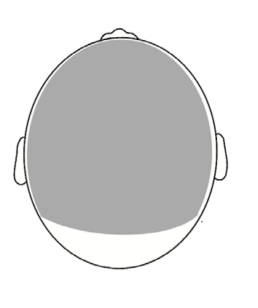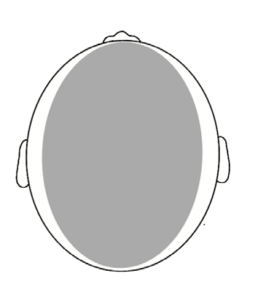Take action for your baby’s health before it’s too late. It is estimated that 4 out of 10 children are affected by a cranial deformity. It’s important to act quickly to prevent this deformity from affecting the child’s skull too much. Current pediatric guidelines recommend varying the baby’s position to avoid positional flattening and reduce the risk of plagiocephaly. However, if a deformity is found, preventive advice and positioning recommendations can be provided.

Plagiocephaly
Plagiocephaly is characterized by diagonal flattening at the back of the skull. The forehead is flattened on the opposite side. An asymmetry of the face is visible. This condition may result from various factors, such as the preferential position of the head during sleep, generating uneven pressure on the developing skull.

Brachycephaly
Brachycephaly is a condition characterized by a head that is shorter and wider than normal. This cranial deformity is often due to the premature fusion of certain cranial sutures, resulting in restricted growth in the length of the skull. In infants, it can sometimes result from prolonged positioning on the back during sleep. Although brachycephaly can be considered a normal phenomenon in some babies, severe cases may require medical intervention, such as sleep reorientation, orthopedic headgear or, in some cases, surgery.

Scaphocephaly
Scaphocephaly is a craniofacial condition characterized by a deformity in the shape of the skull, where it takes on an elongated, narrow appearance. This anomaly often results from premature fusion of the cranial sutures, particularly the sagittal suture. Scaphocephaly can lead to aesthetic and functional problems, sometimes associated with brain development disorders.
Treating plagiocephaly
There are different treatments for plagiocephaly, depending on the factors specific to each case. The child’s age and cranial index are factors to be taken into account. In less severe cases, physiotherapy or osteopathy are generally recommended. For more pronounced cases, where the cranial index is high, wearing an orthosis becomes the treatment of choice.
What are the causes of plagiocephaly?
Intrauterine position
Congenital torticollis
The "protection" position only in dorsal decubitus position (SIDS)
Prematurity
The supine position
Bad positional habits
Schedule an appointment
Booking an appointment has never been so easy! Enter your last name, first name, phone number and date of appointment and our orthotists will contact you within 24 hours. (working hours)




